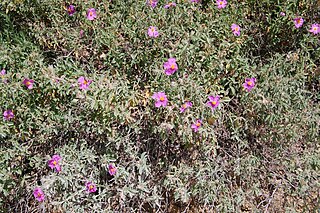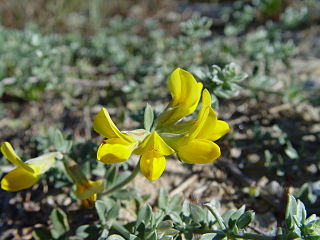Marcus Antonius Creticus, was a Roman politician during the late Roman Republic. He is best known for his failed pirate-hunting career and for being the father of the general Mark Antony.
An agnomen, in the Roman naming convention, was a nickname, just as the cognomen had been initially. However, the cognomina eventually became family names, and so agnomina were needed to distinguish between similarly-named persons. However, as the agnomen was an additional and optional component in a Roman name, not all Romans had an agnomen.

Cistus creticus is a species of shrubby plant in the family Cistaceae. Though it usually has pink flowers, of 4.5–5 cm diameter, this species is very variable. It is widely known as a decorative plant. It is frequently called "Cistus incanus".
Quintus Caecilius Metellus Creticus was a politically active member of the Roman upper class. He was praetor in 74 BC and pontifex from 73 BC until his death. He was consul in 69 BC along with Quintus Hortensius Hortalus.
Quintus Caecilius Metellus Creticus Silanus, born Iunius Silanus was adopted by Quintus Caecilius Metellus, a descendant of the optimate Quintus Caecilius Metellus Creticus and the natural son of Marcus Junius Silanus. He was a Consul in AD 7 and governor of Syria from AD 13 to 17. Silanus was socially connected with the then-heir to the Roman principate Germanicus; his daughter at one time was betrothed to Germanicus' son Nero.
Metajapyx is a genus of forcepstails in the family Japygidae. There are more than 30 described species in Metajapyx.

Cistus × incanusL. is a hybrid between Cistus albidus and Cistus crispus. The name "Cistus incanus" has been used by other authors in a different sense, for Cistus creticus. The English name hoary rock-rose may refer to this species, among others.
Metajapyx athenarum is a species of forcepstail in the family Japygidae.
Metajapyx besucheti is a species of forcepstail in the family Japygidae.
Metajapyx firmus is a species of forcepstail in the family Japygidae.
Metajapyx folsomi is a species of forcepstail in the family Japygidae. It is found in North America.
Metajapyx garganicus is a species of forcepstail in the family Japygidae.
Metajapyx illinoiensis is a species of forcepstail in the family Japygidae. It is found in North America.
Metajapyx magnifimbriatus is a species of forcepstail in the family Japygidae. It is found in North America.
Metajapyx multidens is a species of forcepstail in the family Japygidae. It is found in North America.
Metajapyx parvidens is a species of forcepstail in the family Japygidae.
Metajapyx remingtoni is a species of forcepstail in the family Japygidae. It is found in North America.
Metajapyx steevesi is a species of forcepstail in the family Japygidae. It is found in North America.
Metajapyx subterraneus is a species of forcepstail in the family Japygidae. It is found in North America.

Lotus creticus is a species of perennial herb of the family Fabaceae found in tropical Africa. It is symbiosis-competent and engages in nitrogen-fixing symbiotic interactions with species of the Ensifer genus[3][3]. It comprises three varieties found in the Mediterranean. There is some controversy as to whether each subgroup could be considered the same species but are classically described as being subgroups. Varieties consist of the most commonly cited silky-hairy var. creticus, which is widely distributed in its western part of the coast; the non-silky var. glabrescens, which has a western Mediterranean distribution; and the eastern Mediterranean var. collinus, which is also not silky and can be described by long petioles and peduncles.


